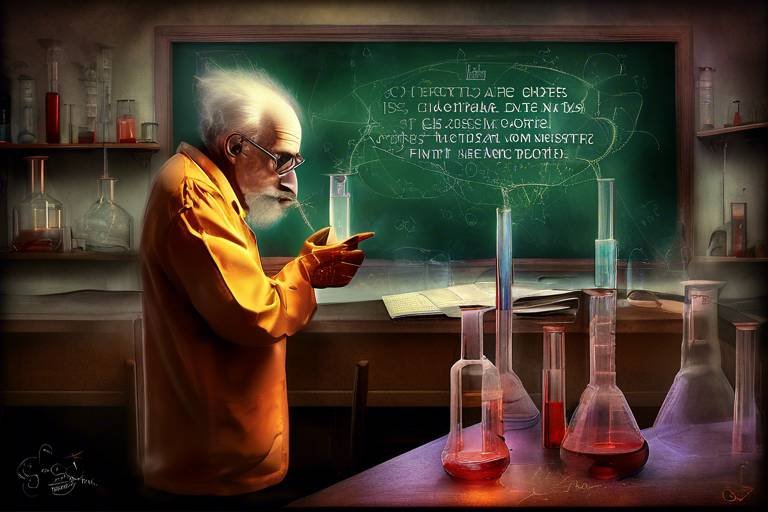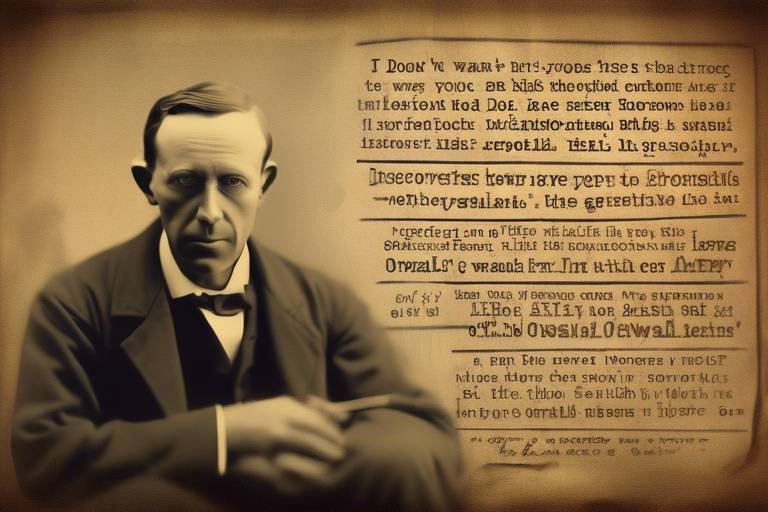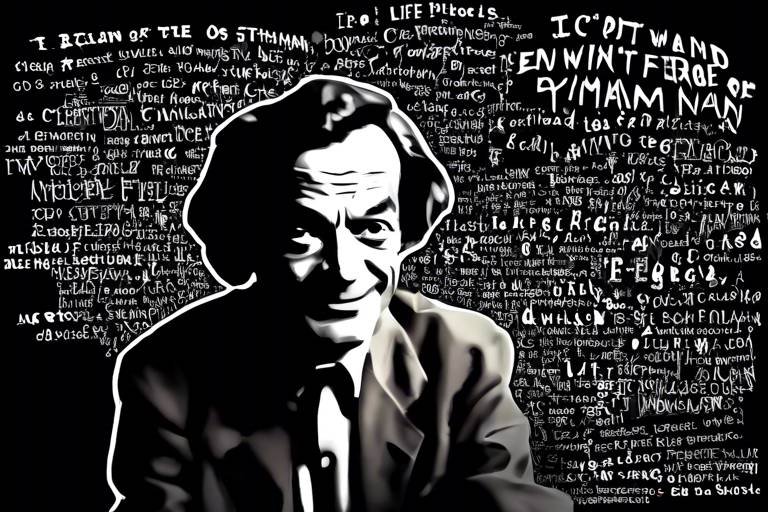The Work of Richard N. Zare in Chemistry and Education
Richard N. Zare is a name that resonates with innovation and excellence in the fields of chemistry and education. With a career that spans decades, Zare has not only made remarkable contributions to scientific research but has also played a pivotal role in shaping the future of science education. His work is characterized by a deep commitment to understanding the intricacies of chemical dynamics and a passion for inspiring the next generation of scientists. In this article, we will delve into the significant contributions of Richard N. Zare, exploring his groundbreaking research, innovative teaching methodologies, and his lasting influence on the scientific community.
Zare's research has transformed our understanding of chemical dynamics and laser spectroscopy, leading to groundbreaking discoveries that have paved the way for new technologies and methods in chemistry. His work has allowed scientists to probe the fundamental aspects of molecular interactions, providing insights that were previously unattainable. Imagine being able to watch a chemical reaction unfold in real time—this is the kind of revolutionary capability that Zare's research has introduced to the scientific world. By employing sophisticated laser techniques, he has opened new avenues for studying the behavior of molecules, which has far-reaching implications across various disciplines.
One of Zare's most significant contributions is his pioneering work in laser spectroscopy. This innovative technique has enabled scientists to observe chemical reactions as they happen, enhancing the precision of analytical methods. The ability to capture molecular interactions in real time has fundamentally changed the landscape of chemical analysis. With laser spectroscopy, researchers can now conduct experiments that yield more accurate measurements and allow for the detection of trace substances in various fields, including environmental science and pharmaceuticals.
The advancements in laser spectroscopy have significantly improved chemical analysis, allowing for more accurate measurements and the detection of trace substances. This precision is particularly crucial in fields such as:
- Environmental Science: Zare's techniques have facilitated the detection of pollutants, helping scientists understand complex atmospheric reactions.
- Pharmaceuticals: Enhanced drug discovery processes have become a reality, as researchers gain a better understanding of molecular interactions.
Zare's techniques have played a crucial role in environmental chemistry. His innovative methodologies have facilitated the detection of pollutants, aiding in the understanding of atmospheric reactions. This work is not just academic; it has real-world implications for environmental protection and sustainability. By comprehensively studying how pollutants interact within our atmosphere, Zare’s research contributes to efforts aimed at mitigating environmental damage and fostering a healthier planet.
In the realm of pharmaceutical research, Zare's methodologies have significantly enhanced drug discovery processes. By enabling researchers to better understand molecular interactions, his work has improved the efficacy of new medications. Imagine the potential of a drug that can target a disease more effectively because of insights gained from Zare's laser spectroscopy techniques! This intersection of chemistry and medicine exemplifies how Zare's research transcends traditional boundaries, fostering advancements that can save lives.
Beyond research, Zare has made substantial contributions to education. He advocates for innovative teaching methods that engage students and foster a deeper understanding of chemistry and scientific inquiry. His belief is that education should not be a passive experience; rather, it should be an interactive journey that sparks curiosity and critical thinking. Zare’s efforts in this regard have revolutionized how chemistry is taught, making it more accessible and enjoyable for students of all backgrounds.
Zare's commitment to science education extends to developing programs that inspire the next generation of scientists. He emphasizes the importance of hands-on learning and critical thinking in chemistry curricula. By integrating real-world applications into the classroom, Zare ensures that students can connect theoretical knowledge with practical experiences. This approach not only enhances learning but also cultivates a passion for science that can last a lifetime.
Through various outreach programs, Zare has encouraged students from diverse backgrounds to pursue careers in science. By providing resources and opportunities to explore chemistry beyond the classroom, he has opened doors for many aspiring scientists. These initiatives are crucial in promoting diversity within the scientific community, ensuring that talent from all walks of life can contribute to the advancement of knowledge.
Zare's collaborations with various educational institutions have led to the development of innovative curricula and workshops. These initiatives aim to enhance the overall quality of science education across different levels. By working closely with educators, Zare ensures that the teaching of chemistry evolves to meet the needs of modern students, preparing them for the challenges of the future.
- What are Richard N. Zare's main contributions to chemistry?
Zare's main contributions include advancements in laser spectroscopy and chemical dynamics, which have transformed our understanding of molecular interactions.
- How has Zare influenced science education?
Zare has advocated for hands-on learning and innovative teaching methods, inspiring students to engage actively with scientific concepts.
- What impact has Zare's research had on environmental science?
His research has facilitated the detection of pollutants and improved our understanding of atmospheric reactions, contributing to environmental protection efforts.

Innovative Research Contributions
Richard N. Zare has been a pivotal figure in the realm of chemistry, and his innovative research contributions have significantly reshaped our understanding of chemical dynamics. With a career spanning several decades, Zare has not only advanced the field but has also ignited a spark of curiosity and exploration among aspiring chemists. His work primarily focuses on the intricacies of molecular interactions and the fundamental principles governing chemical reactions. By harnessing the power of laser technology, he has opened up new frontiers that allow scientists to delve deeper into the mechanisms of chemical processes.
One of the most remarkable aspects of Zare's research is his groundbreaking work in laser spectroscopy. This technique has revolutionized the way chemists observe and analyze chemical reactions. Imagine being able to watch a chemical reaction unfold in real time, capturing every nuance and detail as it happens. Zare's innovations have made this possible, enabling researchers to gain insights that were once thought to be unattainable. His contributions have not only enhanced our theoretical understanding but have also led to practical applications that benefit various industries.
To illustrate the impact of Zare's research, consider the following table that summarizes some of his key contributions:
| Research Area | Key Contribution | Impact |
|---|---|---|
| Chemical Dynamics | Development of techniques to observe molecular interactions | Enhanced understanding of reaction mechanisms |
| Laser Spectroscopy | Pioneering real-time observation of chemical reactions | Improved accuracy in chemical analysis |
| Environmental Chemistry | Methods for detecting pollutants | Contributions to environmental protection efforts |
| Pharmaceutical Research | Innovative approaches to drug discovery | Enhanced efficacy of medications |
These contributions are not just academic; they resonate through various fields, from environmental science to pharmaceuticals. Zare's work has made it possible to detect trace substances in complex mixtures, which is particularly crucial in areas such as environmental monitoring and drug development. For instance, the ability to identify and quantify pollutants in water sources has far-reaching implications for public health and environmental sustainability.
Moreover, Zare's methodologies have proven invaluable in pharmaceutical research, where understanding molecular interactions can lead to breakthroughs in drug efficacy and safety. By applying his laser spectroscopy techniques, researchers can now gain a clearer picture of how drugs interact at the molecular level, ultimately leading to the development of more effective treatments.
In summary, Richard N. Zare's innovative research contributions have not only advanced the field of chemistry but have also paved the way for practical applications that benefit society at large. His work exemplifies the intersection of scientific inquiry and real-world impact, inspiring future generations to explore the wonders of chemistry.

Advancements in Laser Spectroscopy
Richard N. Zare's pioneering work in laser spectroscopy has not only redefined the way we study molecular interactions but has also created a ripple effect across various scientific fields. Imagine being able to watch a chemical reaction unfold in real time, like a live performance where every detail is captured. This is precisely what Zare’s advancements have enabled. By utilizing finely tuned lasers, scientists can now observe the dynamics of molecules as they interact, providing insights that were once thought to be out of reach.
One of the most significant breakthroughs in laser spectroscopy is the development of time-resolved spectroscopy, a technique that allows researchers to track the movement of molecules over incredibly short time scales. This is akin to using a high-speed camera to capture the fleeting moments of a sprinter crossing the finish line. The ability to see these rapid changes has profound implications for understanding reaction mechanisms and the fundamental principles of chemistry.
Moreover, Zare's work has enhanced the precision of analytical techniques, making it possible to detect and quantify trace substances with unparalleled accuracy. For instance, in environmental monitoring, the ability to identify pollutants at minute concentrations can significantly impact public health and safety. This level of detail not only aids in regulatory compliance but also empowers scientists to develop more effective strategies for environmental protection.
In addition to environmental applications, laser spectroscopy has found its way into the pharmaceutical industry, where understanding molecular interactions is crucial for drug development. By employing Zare's methodologies, pharmaceutical researchers can better analyze how drugs interact with their targets at the molecular level. This not only streamlines the drug discovery process but also enhances the efficacy of new medications, ultimately improving patient outcomes.
To illustrate the impact of these advancements, consider the following table that summarizes key applications of laser spectroscopy across different fields:
| Field | Application | Impact |
|---|---|---|
| Environmental Science | Pollutant Detection | Improved monitoring and regulatory compliance |
| Pharmaceuticals | Drug Interaction Analysis | Enhanced drug efficacy and faster development |
| Material Science | Surface Analysis | Better understanding of material properties |
In conclusion, the advancements in laser spectroscopy brought forth by Richard N. Zare are nothing short of revolutionary. They have not only transformed how scientists approach chemical analysis but have also opened new avenues for research and innovation. As we continue to explore the molecular world, Zare's contributions will undoubtedly serve as a foundation for future discoveries, pushing the boundaries of what we know about chemistry and its applications.
- What is laser spectroscopy? Laser spectroscopy is a technique that uses laser light to analyze the interaction of light with matter, allowing scientists to study molecular properties and dynamics.
- How has Richard N. Zare contributed to laser spectroscopy? Zare has developed innovative techniques that enhance the precision and capabilities of laser spectroscopy, enabling real-time observation of chemical reactions.
- What are some applications of laser spectroscopy? Applications include environmental monitoring, pharmaceutical research, and material science, among others.
- Why is real-time observation important in chemistry? Real-time observation allows scientists to understand the dynamics of chemical reactions, leading to better insights and advancements in various fields.

Applications in Chemical Analysis
Richard N. Zare's groundbreaking advancements in laser spectroscopy have revolutionized the field of chemical analysis. Imagine being able to observe a chemical reaction as it happens, almost like watching a live performance unfold on stage. This is precisely what Zare's techniques enable scientists to do. By harnessing the power of lasers, researchers can now study molecular interactions with unprecedented precision and speed. This real-time observation is not just a scientific novelty; it has practical implications that resonate across various industries.
One of the most significant impacts of Zare's work is in the realm of environmental science. With the ability to detect trace substances in complex mixtures, scientists can now identify pollutants in air and water samples more accurately than ever before. This capability is crucial for assessing environmental health and developing strategies for pollution control. For instance, Zare's methodologies allow for the detection of harmful chemicals at concentrations as low as parts per trillion, which is vital for safeguarding ecosystems and public health.
Moreover, Zare's innovations have also made waves in the pharmaceutical industry. The ability to analyze molecular interactions in real time means that researchers can better understand how drugs interact with their targets in the body. This insight is invaluable during the drug discovery process, where the goal is to develop effective medications with minimal side effects. By employing Zare's laser spectroscopy techniques, pharmaceutical scientists can streamline their research, making it faster and more efficient.
In addition to environmental and pharmaceutical applications, Zare's work has extended to several other fields, such as:
- Food Safety: Detecting contaminants and ensuring the quality of food products.
- Material Science: Analyzing the properties of new materials at the molecular level.
- Forensic Science: Enhancing the analysis of crime scene evidence.
The versatility of laser spectroscopy, as pioneered by Zare, underscores its importance across these diverse applications. By providing scientists with the tools to conduct more accurate measurements, Zare has not only advanced the field of chemistry but has also contributed to the broader goal of improving societal well-being. As we continue to face global challenges such as climate change and public health crises, the role of innovative chemical analysis methods becomes increasingly critical.
In summary, Richard N. Zare's contributions to chemical analysis through laser spectroscopy have opened new doors for scientists, enabling them to tackle complex problems with greater efficiency and accuracy. His work exemplifies how innovation in research can lead to tangible benefits in various sectors, ultimately enriching our understanding of the world and enhancing the quality of life.
- What is laser spectroscopy?
Laser spectroscopy is a technique that uses laser light to analyze the interactions of molecules, allowing scientists to study chemical reactions in real time. - How has Richard N. Zare contributed to chemistry?
Zare has made significant advancements in laser spectroscopy, transforming our understanding of chemical dynamics and enabling precise measurements in chemical analysis. - What are some applications of Zare's research?
Zare's research has applications in environmental science, pharmaceuticals, food safety, material science, and forensic science.

Impact on Environmental Chemistry
Richard N. Zare's contributions to environmental chemistry are nothing short of revolutionary. His innovative techniques in laser spectroscopy have provided scientists with the tools necessary to detect pollutants in our atmosphere and water systems with unprecedented accuracy. Imagine being able to pinpoint harmful substances in the environment as easily as taking a snapshot—it’s this level of precision that Zare's work has brought to the field. By enabling real-time observation of chemical reactions, his research has allowed scientists to better understand the dynamics of pollutants and their interactions with various environmental factors.
One of the most significant impacts of Zare's research is the ability to monitor air quality and track the presence of greenhouse gases. With rising concerns about climate change, the need for accurate data on atmospheric reactions has become essential. Zare's methodologies facilitate the detection of trace gases, providing critical information that helps policymakers make informed decisions about environmental regulations and public health initiatives. For instance, his techniques can identify the presence of volatile organic compounds (VOCs) that contribute to air pollution, allowing for targeted interventions.
Moreover, Zare's work extends to understanding the chemistry of water systems. His innovative approaches have improved the detection of contaminants in drinking water, which is a pressing issue worldwide. By utilizing advanced laser techniques, researchers can now identify trace levels of harmful substances, such as heavy metals and pesticides, which can have dire consequences on human health. This level of detection is vital for ensuring safe drinking water and protecting public health.
To illustrate the impact of Zare's research, consider the following table that summarizes key contributions and their implications:
| Contribution | Implication |
|---|---|
| Real-time monitoring of pollutants | Enhanced ability to track environmental changes and respond to pollution events |
| Detection of trace gases in the atmosphere | Improved understanding of climate change dynamics and air quality |
| Advanced water contamination detection | Increased safety in drinking water and public health protection |
In conclusion, the impact of Richard N. Zare on environmental chemistry is profound. His pioneering work not only enhances our understanding of chemical interactions in the environment but also plays a crucial role in the ongoing efforts to combat pollution and environmental degradation. As we face increasing environmental challenges, the methodologies developed by Zare will undoubtedly continue to be at the forefront of scientific research, paving the way for a more sustainable future.
- What is laser spectroscopy? Laser spectroscopy is a technique that uses lasers to analyze the interaction of light with matter, allowing scientists to study molecular structures and dynamics.
- How has Zare's work influenced environmental policy? Zare's research provides critical data on pollutants, which helps inform environmental regulations and public health initiatives.
- What are some applications of Zare's techniques? His techniques are used in air quality monitoring, water contamination detection, and studying chemical reactions in the atmosphere.
- Why is real-time monitoring of pollutants important? Real-time monitoring allows for immediate responses to pollution events, enhancing public safety and environmental protection efforts.

Influence on Pharmaceutical Research
Richard N. Zare's influence on pharmaceutical research is nothing short of revolutionary. His innovative methodologies have significantly enhanced the drug discovery process, allowing researchers to delve deeper into the complexities of molecular interactions. Imagine trying to find a needle in a haystack, but instead of a needle, it’s a life-saving drug, and instead of a haystack, it’s a vast sea of molecular structures. Zare’s work provides the tools that make this daunting task not only feasible but also efficient.
One of the key advancements Zare introduced is the use of laser spectroscopy in understanding how drugs interact with biological systems. This technique allows scientists to visualize and analyze these interactions at an unprecedented level of detail. For instance, when a new drug is developed, understanding its binding affinity to a target protein can determine its efficacy. Zare's methods enable researchers to observe these interactions in real-time, providing insights that were previously impossible to obtain.
Furthermore, Zare's research has facilitated the identification of potential drug candidates more rapidly. By employing advanced spectroscopic techniques, pharmaceutical scientists can screen thousands of compounds quickly, pinpointing those that show promise for treating specific diseases. This not only accelerates the pace of drug development but also reduces the costs associated with bringing new medications to market. In an industry where time is money, Zare's contributions are invaluable.
To illustrate the impact of Zare's work, consider the following table that highlights some of the key advancements in pharmaceutical research stemming from his techniques:
| Advancement | Description | Impact |
|---|---|---|
| Real-Time Molecular Interaction Studies | Using laser spectroscopy to observe drug-target interactions as they occur. | Enhanced understanding of drug mechanisms, leading to more effective therapies. |
| High-Throughput Screening | Rapidly testing large libraries of compounds for biological activity. | Faster identification of promising drug candidates, reducing development timelines. |
| Improved Binding Affinity Measurements | Accurate quantification of how well a drug binds to its target. | Better prediction of drug efficacy and safety profiles. |
In addition to these advancements, Zare's emphasis on interdisciplinary collaboration has fostered partnerships between chemists, biologists, and pharmacologists. This collaborative spirit is essential in pharmaceutical research, where the integration of diverse expertise can lead to breakthroughs in understanding complex diseases and developing novel therapies. By bridging the gap between chemistry and biology, Zare has not only advanced the science but also inspired a new generation of researchers to think outside the box.
Ultimately, Richard N. Zare's influence on pharmaceutical research is a testament to the power of innovation in science. His contributions have not only improved the methodologies used in drug discovery but have also paved the way for new treatments that can change lives. As we continue to face global health challenges, the importance of Zare's work becomes even more apparent, reminding us that the intersection of chemistry and medicine holds the key to future advancements.
- What is laser spectroscopy? Laser spectroscopy is a technique that uses lasers to analyze the interaction of light with matter, providing insights into molecular structures and dynamics.
- How has Zare influenced drug discovery? Zare's methodologies allow for real-time observation of molecular interactions, enhancing the speed and accuracy of drug development.
- Why is interdisciplinary collaboration important in pharmaceutical research? It brings together diverse expertise, leading to innovative solutions and breakthroughs in understanding complex diseases.

Educational Innovations
Richard N. Zare's impact on education goes far beyond traditional teaching methods; he has become a beacon of innovation in the world of science education. Zare believes that engaging students in chemistry is not just about delivering lectures but about creating an interactive and stimulating environment where curiosity can thrive. By incorporating modern technologies and hands-on experiments, he has transformed the way students perceive and understand chemistry. This approach not only makes learning more enjoyable but also helps students retain complex concepts more effectively.
One of the key aspects of Zare's educational innovations is his emphasis on active learning. In his classrooms, you won't find students passively sitting and taking notes. Instead, they are encouraged to participate in discussions, conduct experiments, and solve real-world problems. This method fosters critical thinking skills and allows students to apply their knowledge in practical situations. For instance, Zare often incorporates the use of laser spectroscopy demonstrations in his lectures, allowing students to witness the principles of chemistry in action. Such experiences not only enhance understanding but also ignite a passion for science.
Moreover, Zare has been instrumental in developing outreach programs aimed at inspiring young scientists, especially those from underrepresented backgrounds. These programs focus on providing resources, mentorship, and hands-on experiences that make science accessible and exciting. By breaking down barriers and offering opportunities, Zare ensures that the next generation of chemists is diverse and well-equipped to tackle the challenges of the future. In fact, many of his students have gone on to pursue successful careers in various scientific fields, a testament to his effective teaching methods.
In collaboration with various educational institutions, Zare has also worked to create innovative curricula that reflect the latest advancements in chemistry. This includes integrating technology into the classroom, such as using computer simulations and data analysis tools that mimic real-life scientific research. By bridging the gap between theoretical knowledge and practical application, these curricula prepare students not only for academic success but also for real-world challenges they may face in their careers.
To summarize, Richard N. Zare's contributions to educational innovations are profound and far-reaching. His commitment to enhancing the quality of science education has reshaped the way chemistry is taught and learned. By fostering an environment of curiosity, collaboration, and real-world application, Zare is not just teaching chemistry; he is inspiring a new generation of scientists to explore the wonders of the chemical world.
- What teaching methods does Richard N. Zare advocate for? Zare promotes active learning, hands-on experiments, and the use of modern technologies to engage students in chemistry.
- How has Zare contributed to outreach programs? He has developed programs aimed at inspiring students from diverse backgrounds to pursue careers in science, providing them with resources and mentorship.
- What impact has Zare's work had on students? Many of his students have gone on to successful careers in science, demonstrating the effectiveness of his teaching methodologies.
- How does Zare integrate technology into education? He incorporates computer simulations and data analysis tools into the curriculum, bridging the gap between theory and practical application.

Promoting Science Education
Richard N. Zare's commitment to science education is nothing short of inspiring. He believes that the future of scientific discovery hinges on the ability to engage young minds and cultivate their curiosity. By developing innovative programs and methodologies, Zare has made it his mission to ignite a passion for chemistry among students of all backgrounds. His approach is not just about imparting knowledge; it's about creating an environment where students can actively participate in their learning journey.
One of the cornerstones of Zare's educational philosophy is the emphasis on hands-on learning. He understands that chemistry can sometimes seem abstract and distant, but by bringing practical experiments into the classroom, students can see the real-world applications of their studies. Imagine a classroom where students are not just reading about chemical reactions but are actually conducting experiments, observing the reactions unfold right before their eyes. This experiential learning fosters a deeper understanding and appreciation for the subject.
Additionally, Zare has been instrumental in establishing outreach programs aimed at underrepresented groups in science. These initiatives provide students with resources, mentorship, and opportunities to explore the fascinating world of chemistry. By breaking down barriers and making science accessible, Zare is helping to build a more diverse scientific community. The impact of these outreach efforts can be profound, as they not only encourage students to pursue careers in science but also empower them to contribute to the field in meaningful ways.
Moreover, Zare's collaborations with educational institutions have led to the creation of innovative curricula and workshops designed to enhance the quality of science education. These programs often incorporate the latest research findings and teaching techniques, ensuring that students receive a modern and relevant education. For instance, workshops may focus on the integration of technology in the classroom, showcasing how tools like simulations and digital labs can enhance the learning experience.
In summary, Richard N. Zare's contributions to promoting science education are multifaceted and impactful. His focus on hands-on learning, outreach programs, and innovative curricula not only enriches the educational landscape but also inspires a new generation of scientists. As we look to the future, it's clear that Zare's efforts will continue to resonate, paving the way for advancements in chemistry and beyond.
- What is Richard N. Zare known for?
Zare is renowned for his groundbreaking research in chemistry, particularly in the fields of chemical dynamics and laser spectroscopy, as well as his commitment to enhancing science education. - How does Zare promote science education?
He promotes science education through hands-on learning experiences, outreach programs for underrepresented students, and collaborations with educational institutions to develop innovative curricula. - Why is hands-on learning important in science education?
Hands-on learning allows students to engage directly with scientific concepts, making the material more relatable and easier to understand, thus fostering a deeper appreciation for the subject. - What impact do outreach programs have?
Outreach programs help to inspire and empower students from diverse backgrounds to pursue careers in science, contributing to a more inclusive scientific community.

Outreach Programs for Students
Richard N. Zare has always believed that the future of science lies in the hands of the youth. His outreach programs are a testament to this belief, as they aim to inspire and empower students from various backgrounds to explore the fascinating world of chemistry. Imagine walking into a classroom where students are not just passive listeners but active participants in their learning journey! Zare’s initiatives have transformed traditional learning into an engaging and interactive experience, making science not just a subject but a passion.
One of the key components of Zare's outreach programs is the emphasis on hands-on learning. Students are encouraged to conduct experiments, engage in group discussions, and solve real-world problems. This approach not only makes learning fun but also helps students develop critical thinking skills that are essential in today’s scientific landscape. For instance, during workshops, students might work on projects that involve environmental issues, such as analyzing local water quality or studying the effects of pollutants, which ties their learning directly to the world around them.
Moreover, Zare's outreach programs are designed to reach students from underrepresented communities, ensuring that everyone has the opportunity to explore the sciences. By providing resources such as scholarships, laboratory equipment, and mentorship, Zare is breaking down barriers and opening doors for aspiring scientists. The impact of these programs is profound, as they not only cultivate interest in chemistry but also encourage diversity in the scientific community.
To illustrate the success of these outreach initiatives, let’s take a look at some of the key features:
| Program Feature | Description |
|---|---|
| Hands-on Workshops | Interactive sessions where students conduct experiments and engage in scientific discussions. |
| Mentorship Opportunities | Pairing students with experienced scientists to guide them through their scientific inquiries. |
| Scholarship Programs | Financial support for students from underrepresented backgrounds pursuing science education. |
| Community Engagement | Projects that involve local environmental issues, fostering a connection between students and their communities. |
In conclusion, Richard N. Zare’s outreach programs are more than just educational initiatives; they are a movement towards creating a more inclusive and passionate scientific community. By investing time and resources into these programs, Zare is not only nurturing the next generation of scientists but also ensuring that the field of chemistry continues to thrive with fresh ideas and diverse perspectives.
- What age group do the outreach programs target? The outreach programs primarily target middle and high school students, but they also have initiatives for younger children.
- How can students get involved in these programs? Interested students can check with their schools or local educational institutions for information on upcoming workshops and events organized by Zare's team.
- Are there any costs associated with participating in the outreach programs? Most outreach programs are free of charge, as they aim to provide equal opportunities for all students.
- What kind of experiments do students conduct during workshops? Students engage in a variety of experiments that relate to real-world issues, such as environmental science, chemical reactions, and materials science.

Collaboration with Educational Institutions
Richard N. Zare's collaborations with educational institutions have been nothing short of transformative. By partnering with various universities and colleges, Zare has been instrumental in designing curricula that not only meet the current demands of the scientific community but also ignite a passion for chemistry among students. Imagine a classroom where students are not just passive listeners but active participants in their learning journey! Zare's innovative approaches breathe life into traditional teaching methods, making chemistry more accessible and exciting.
One of the hallmark aspects of Zare's collaborations is the focus on hands-on learning experiences. He believes that true understanding comes from doing, and this philosophy has led to the development of numerous workshops and laboratory sessions that encourage students to engage directly with scientific concepts. For instance, through his initiatives, students can participate in real-time experiments that utilize advanced laser spectroscopy techniques, allowing them to see the principles of chemistry in action. This experiential learning not only solidifies theoretical knowledge but also builds critical thinking and problem-solving skills.
Moreover, Zare's partnerships extend beyond the classroom walls. He has worked closely with educational institutions to create outreach programs that target underrepresented communities in science. These programs aim to provide resources, mentorship, and opportunities for students who may not have had access to quality science education. By doing so, Zare is not just shaping the future of chemistry; he is also ensuring that it is inclusive and diverse. The impact of these initiatives can be profound, as they help to cultivate a new generation of scientists who bring unique perspectives and innovations to the field.
To illustrate the breadth of Zare's collaborations, consider the following table that highlights some key partnerships and their outcomes:
| Institution | Program/Initiative | Outcome |
|---|---|---|
| Stanford University | Advanced Chemistry Workshops | Enhanced student engagement and understanding of chemical dynamics. |
| Community Colleges | Outreach Programs | Increased enrollment of underrepresented students in STEM fields. |
| High Schools | Interactive Chemistry Labs | Improved student performance in chemistry courses. |
In summary, Richard N. Zare's collaborations with educational institutions exemplify a commitment to enhancing science education. By fostering innovative curricula, promoting hands-on learning, and advocating for inclusivity in STEM, he is not only enriching the academic landscape but also inspiring students to pursue careers in science. His efforts remind us that education is not just about imparting knowledge; it's about igniting curiosity and passion in the next generation of scientists.
- What is Richard N. Zare known for?
Zare is renowned for his contributions to chemical dynamics and laser spectroscopy, as well as his innovative teaching methods in science education. - How has Zare influenced science education?
He has developed curricula and outreach programs that promote hands-on learning and encourage diversity in STEM fields. - What impact has Zare's research had on environmental science?
His techniques have improved the detection of pollutants and advanced our understanding of atmospheric chemistry. - Can students participate in Zare's programs?
Yes, many of Zare's initiatives are designed to engage students from various backgrounds in hands-on scientific experiences.
Frequently Asked Questions
- What are Richard N. Zare's main contributions to chemistry?
Richard N. Zare has made groundbreaking contributions in the fields of chemical dynamics and laser spectroscopy. His innovative research has transformed our understanding of molecular interactions and has led to the development of new technologies and methods in chemistry.
- How has Zare's work impacted laser spectroscopy?
Zare's pioneering work in laser spectroscopy has revolutionized the way scientists study chemical reactions. His techniques allow for real-time observation of molecular interactions, which enhances the precision of analytical methods used in various scientific fields.
- What applications does Zare's research have in environmental chemistry?
Zare's techniques have significantly advanced environmental chemistry by facilitating the detection of pollutants and understanding atmospheric reactions. This work contributes to environmental protection and sustainability efforts, making it crucial for addressing climate change and pollution.
- In what ways has Zare influenced pharmaceutical research?
In the realm of pharmaceutical research, Zare's methodologies have improved drug discovery processes. His work helps researchers better understand molecular interactions, which in turn enhances the efficacy of new medications and accelerates their development.
- How does Zare promote science education?
Zare is deeply committed to science education and has developed programs that inspire the next generation of scientists. He emphasizes hands-on learning and critical thinking, making chemistry more engaging for students at all levels.
- What types of outreach programs has Zare implemented for students?
Zare's outreach programs aim to encourage students from diverse backgrounds to pursue careers in science. These initiatives provide resources and opportunities for students to explore chemistry beyond the classroom, fostering a love for the subject.
- How has Zare collaborated with educational institutions?
Through collaborations with various educational institutions, Zare has helped develop innovative curricula and workshops. These efforts are designed to enhance the quality of science education, ensuring that students receive a comprehensive and engaging learning experience.



















